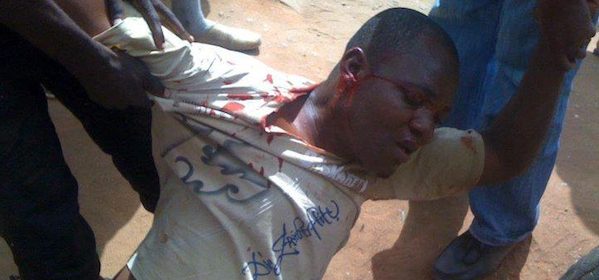Police Detain 23 at Anti-Government Protest in Luanda

Angolan police detained 23 protestors, including an opposition official, near Luanda’s Largo de Independência on Thursday afternoon in connection with an attempted anti-government demonstration by the informal group of youths known as the Angolan Revolutionary Movement (ARM).
A 2,000-strong police contingent, including armed police with machine guns and dogs and hundreds of state security agents, prevented the demonstration from occurring.
At 12.30 p.m. police detained Manuel de Victória Pereira, who is both the national secretary of the Bloco Democrático party and the vice-president of the National Teachers’ Union, in the vicinity of Largo de Independência. Pereira was distributing party leaflets when he was detained. In a press statement, Bloco Democrático condemned the detention as a “contemptible” act that “confirms the dictatorial character of the current executive.”
Police also seized Coque Mukuta, a Voice of America correspondent, for 30 minutes after he tried to check the name of a demonstrator who had been detained at the SantAna cemetery.
“When the commanding officer saw my press pass, he said I must stay there with them because I was interfering with their work. After making some phone calls, he got annoyed, insulted my mother, hit me with my card on my chest and sent me away,” Mr. Mukuta told Maka Angola.
Before the scheduled start of the demonstration at 3 p.m., police detained Adolfo António, Adolfo Campos, Amândio Canhanga, Belenguete Kawelele, Carlos Felipe Mavuzanga “Sufixo”, “Dilma Roussef”, Quintuango Mabiala, Pedrowski Teca, Fernando José da Silva, Emiliano Catumbela and Roberto Gamba “Pastor”, all associated with ARM.
“Quintuango Mabiala and Roberto Gamba are being beaten at this very moment at the Ninth Police Station in Sambizanga,” demonstrator Alex Chabalala told Maka Angola.
Luís Francisco, who demonstrated with 20 colleagues, managed to avoid being detained and beaten, but confirmed to Maka Angola that one demonstrator had been left unconscious.
“We left one colleague of ours lying unconscious on the ground. The police were stamping on his head and abdomen with their boots. They were beating him brutally. We are trying to find out his name and whether he was taken to hospital or to prison,” Francisco said.
Late at night, Maka Angola confirmed the detention and the identities of ten other protesters at the 3rd Police Station, who had been kept in two separate groups. This brought the total of confirmed and identified protesters to a total of 23. However, the National Police only acknowledged publicly the detention of seven youths. Most were released after 11 p.m.
On September 18, the day before the scheduled demonstration, Commissioner Aristófanes dos Santos, the spokesman for Luanda’s Police Headquarters, announced on Angolan Public Television (TPA) that the police were ready to stop the demonstration. “We will repel – I repeat, vehemently repel – all acts contrary to public order and security and we will use force if necessary,” he said.
Apart from the strong police presence around Largo da Independência, several members of ARM found their homes surrounded early in the morning. Raúl Mandela told Maka Angola how he had to leave his home in Viana before daybreak. “My family phoned me later to tell me there were three patrolmen around the house to stop me from leaving.”
Emiliano Catumbela, who was arrested during an attempted demonstration in May, said that on Thursday there were plainclothes police and security agents waiting outside his workplace to prevent him from joining the demonstration.
Meanwhile, a 32-year-old demonstrator called André Francisco “Sovi” benefited from an act of public solidarity. As police and security agents were chasing him, he sought refuge in a school next to the square. “A teacher asked what I was doing. I didn’t lie. I told him explicitly that I was a demonstrator and he hid me. A bit later he put me in the boot of his car and gave me a lift to a secure place.”
The youths had announced the demonstration as a peaceful protest against social injustice. However, an anonymous pamphlet was circulated in some neighborhoods of Luanda calling for an armed demonstration. The police and state media have been using this pamphlet to accuse the youth demonstrators of trying to start a “war” in Angola.
“These crooks who made this fake pamphlet to cast doubts on the Revolutionary Movement’s pacifist approach included my phone number and the numbers of other activists so as to accuse us. This is the work of the government itself,” Chabalala said.
President José Eduardo dos Santos has ruled Angola for 34 years. The country is Africa’s second oil producer and two-thirds of its estimated 20 million population are under 25. In a televised interview in June, the President referred to the youth protesting his decades-long tenure as “a group of 300 frustrated individuals.”
